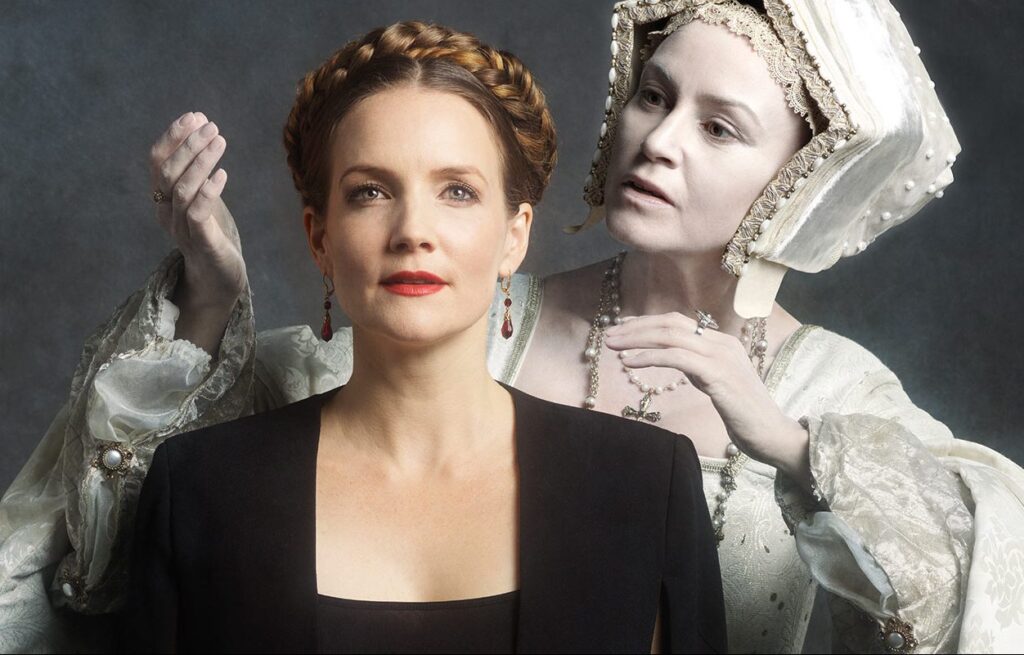
Mother’s Daughter at The Stratford Festival
Unless you hold a cum laude degree in English History you will be well advised to arrive at the Stratford Festival’s Studio Theatre early so you can pore over the program notes for Kate Hennig’s Mother’s Daughter.
Pay special attention to the two-page Tudor Timeline. Those of us laboring under the misapprehension that the royal line of succession went from Henry VIII to Elizabeth I will be surprised to find that between Henry and Queen Bess there was not only another king, Henry’s only son Edward (VI) but two other queens. One of them ruled England for just 9 days.
Mother’s Daughter is the third in a trilogy in which Hennig explores the trials, tribulations, and occasional triumphs of the women in Henry VIII’s extended family. The others, which also premiered at Stratford, are The Last Wife and The Virgin Trial.
Hennig is more interested in “interrogating” (can we declare a theatrical moratorium on that word?) the themes and personalities of the Tudor era than in historical accuracy, another reason for boning up on your history. The costumes are largely contemporary as is the electric set (both by Lorenzo Savoini) and the language is decidedly so. I seriously doubt anyone in the Tudor era used the phrase “crawling up the ass of the patriarchy.”
In this play the focus is on Queen Mary (a commanding Shannon Taylor) who reigned for about four years before dying childless, whereupon Elizabeth ascended to the throne. This is “Bloody Mary,” not to be confused with the better remembered Mary Queen of Scots. There’s that pesky history again.
A constant presence in Mary’s troubled life is the shade of her mother Catalina – better known to posterity as Catherine of Aragon, Henry VIII’s first wife. Henry, eager for a male heir, arranged to have that marriage annulled so he could marry Anne Boleyn, who shortly gave birth to Elizabeth. The annulment precipitated Henry’s break with Rome and the establishment of the Church of England. Are we following so far?
Perhaps unsurprisingly, Catalina (an impressive Irene Poole) has some “issues” with the way she was treated and in the interest of perpetuating her own bloodline she relentlessly presses Mary to consolidate her power in the time-honored way of monarchs everywhere – by killing everyone who might challenge her right to the throne, starting with her cousin Jane Grey (Andrea Rankin) and her half-sister Elizabeth (Jessica B. Hill), while she searches for a suitable husband with whom to produce an heir.
But Mary vacillates, at first thinking that clemency will win over her enemies. A complicating factor is that Mary clings to the old religion, while Jane and Elizabeth have embraced Protestantism. She pleads with Jane to convert to no avail.
In Hennig’s version, Mary emerges as a less than resolute ruler. She hems and haws and continues to take an inordinate amount of guff from her counselor Simon (a quietly forceful Gordon Patrick White) long after her father would have said “Off with his head!”
Eventually, she gets with the program, doubles down on reinstating Catholicism, and starts reprisals against her enemies (there’s a reason she’s known to history as “Bloody Mary”). Jane Grey is beheaded and Elizabeth seems to be on shaky ground. There are heated arguments between Mary and Elizabeth and among Mary and the shades of her mother and Anne Boleyn (Ms. Hill again). The double casting is a bit confusing at first, but Hennig is making the point that both Mary and Elizabeth are their mother’s daughter.
Although her death is not depicted in the play, Mary eventually succumbed to an unknown illness, which in this production looks an awful lot like a virulent form of stomach cancer, before her marriage to Philip of Spain (also not depicted) can produce issue.
Hennig’s play is a heady brew of themes – religious absolutism versus religious tolerance, compassion versus ruthlessness, sisterly love versus the imperatives of power, the struggle of these women to impose their own vision of what the monarchy should be while navigating a culture that devalues them.
I suspect many will find it talky and hard to follow and truth be told Hennig doesn’t make it easy. What will be crystal clear however are the powerful performances director Alan Dilworth has elicited from his cast. Poole, Rankin, Hill, and White are all excellent, and with this production Shannon Taylor, who is onstage for the play’s entire two hours, takes her place as one of the Festival’s great leading ladies.
Perhaps someday we will be able to see all three plays within a short period of time, perhaps in repertory, staged with a unified visual aesthetic, with the same actresses appearing in the roles that repeat. That would be a theatrical event worth traveling for. Now that Hennig has become the associate artistic director of the Shaw Festival, perhaps this is an honor they will accord her.
More Reviews
To access the complete archive of reviews listed alphabetically CLICK HERE.

